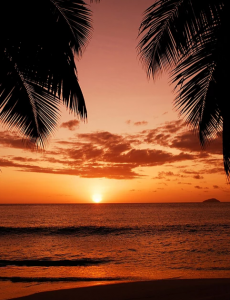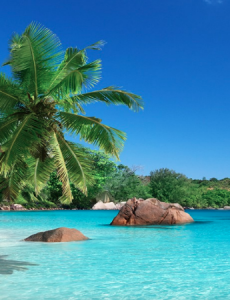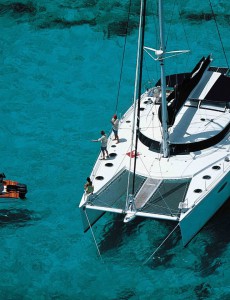
Seychelles
The Essence of the Seychelles: A Paradise Unveiled by the Sea
The Seychelles is not just a tropical getaway—it’s a slice of heaven where nature and the sea form a harmonious, unspoiled paradise. The archipelago is made up of over 115 islands, each with its own unique character and charm. Whether you're basking on powdery white beaches, swimming in crystal-clear waters, or exploring hidden coves, the Seychelles offers something for everyone, inviting travelers to slow down and immerse themselves in its beauty.
Arriving in the Seychelles is an experience in itself. As your plane descends over the vast expanse of turquoise waters, the islands come into view—an untouched paradise where lush jungles meet coral reefs. On the ground, the Seychelles weather welcomes you with warm temperatures year-round, making it an ideal year-round destination for both relaxation and adventure. Its islands, surrounded by vibrant coral reefs and rich marine life, provide the perfect opportunity for exploration, whether on land or at sea.
The beauty of the Seychelles lies not only in its physical landscapes but in its intimate connection to the sea. Its coastline, marked by rugged granite outcrops, lagoons, and palm-fringed beaches, is best explored by boat. Whether cruising along the shores of Mahé, Praslin, or La Digue, you’ll be surrounded by the sights and sounds of a living ecosystem—graceful sea turtles, playful dolphins, and vibrant schools of fish beneath the surface. The calm, shallow waters make it an ideal destination for Seychelles snorkeling, as well as for diving, swimming, and sailing.
For those planning their Seychelles itinerary, there’s no shortage of things to do. From the lush rainforests and nature reserves on Praslin to the majestic granite peaks of Mahé, every island offers something new to discover. Whether you are looking for adventure, romance, or a quiet retreat, the Seychelles will leave you with memories of unparalleled natural beauty and serenity.
The Seychelles is waiting for you to experience its magic—whether you're ready to explore the underwater world, hike to panoramic views, or simply relax in the sun, this archipelago promises an unforgettable journey.


Island-Hopping in Paradise: Sailing the Seychelles by Sea
Sailing through the Seychelles is not just a way to travel—it’s a way to belong. The rhythm of the Indian Ocean gently guides you from one island to the next, where granite cliffs, coral-ringed lagoons, and white sand beaches unfold like a private gallery of nature. There are few places where a sailing journey feels as effortless and rewarding as it does here.
The 115 islands that make up the archipelago are ideally spaced for navigation. Short passages connect major stops like Mahé, Praslin, and La Digue, while more remote islets—Curieuse, Cousin, and Félicité—offer tranquil bays and anchorages surrounded by marine reserves. Along the way, you’ll experience some of the most pristine snorkeling in the region, with vibrant coral gardens teeming with life, colorful fish, and the occasional graceful sea turtle gliding alongside your hull.
Sailing Seychelles means experiencing freedom without sacrificing comfort. You can begin your adventure in Eden Island Marina, setting a flexible route based on weather and mood. Most itineraries include anchorages at Anse Lazio on Praslin, known for its dramatic granite boulders, or Baie Sainte Anne, a picturesque natural harbor. La Digue’s coastline, where ox carts still outnumber cars, offers stunning views and calm anchoring spots perfect for long swims and island strolls.
Whether you're planning a Seychelles yacht charter or looking into a Seychelles catamaran charter, the experience is designed for fluid exploration. For those seeking local guidance, a skipper charter Seychelles ensures access to hidden coves and optimal mooring points, especially within the marine parks.
Is Seychelles good for sailing? Absolutely. The weather is mild, the seas are calm, and the routes are accessible year-round, making it a top-tier sailing destination for both seasoned sailors and first-timers.
To experience the very best of a Seychelles sailing cruise, IntersailClub offers curated itineraries built on local knowledge, timing each crossing to match the wind and revealing a new facet of the islands with every nautical mile.

Echoes of the Ocean: Tracing the Cultural Soul of the Seychelles
The cultural tapestry of the Seychelles is as vivid and layered as its landscapes. These islands, scattered across the Indian Ocean, hold centuries of stories shaped by seafarers, traders, colonizers, and the ocean itself. Unlike destinations where history is carved into monuments, the Seychelles' history is whispered through wooden boats, market conversations, and the rhythm of coastal life.
From the earliest settlements by African, European, and Asian voyagers, the islands evolved into a crossroads of maritime influences. The Creole culture that defines Seychelles life today emerged from this fusion—expressed in language, music, cuisine, and architecture. In fishing villages along Mahé and Praslin, you’ll still hear Sega music drifting from porches, taste spicy ladob dishes prepared with local breadfruit and coconut, and see colonial houses with fretwork balconies overlooking the sea.
While the archipelago may not boast massive ruins, it hides a subtle and rich Seychelles archaeology. On Silhouette Island and Curieuse, archaeological sites hint at early settlements and plantations, where nature has now reclaimed the past. Walks inland reveal ruins of old distilleries and burial grounds, their stones covered in moss but still resonating with memory.
Seychelles culture also flourishes in the arts: from handcrafted model pirogues to vibrant market textiles and painted coconut husks. In towns like Victoria, galleries and open-air fairs give space to local artists inspired by marine life and Creole heritage.
What cultural influences shape Seychelles’ identity? The answer is found in the islands’ relationship with nature. Culture here is deeply tied to the sea—sailing, fishing, storytelling, and community rituals. Whether it's a Sunday barbecue on the beach, a village regatta, or the craftsmanship of a dugout canoe, islanders live in dialogue with their environment.
To explore the Seychelles is to enter a living culture carried by tides and traditions. And for those arriving by boat, every cove becomes a doorway into a story, every anchorage a place where history, nature, and human life gently converge.
Sailing by the Seasons: Understanding Seychelles’ Rhythms
June is the hottest month in Havana with an average temperature of 27°C (81°F) and the coldest is January at 21°C (70°F) with the most daily sunshine hours at 11 in July. The wettest month is June with an average of 80mm of rain. The best month to swim in the sea is in August when the average sea temperature is 30°C (86°F).
Check all Statistics in Accuweather














